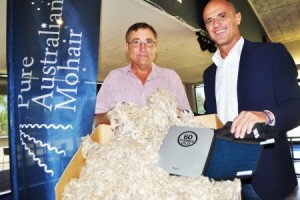 AUSTRALIAN Angora producers are primed to grow the best mohair in the world following a visit from Italy’s biggest spinner, who can’t get enough of their premium clip.
AUSTRALIAN Angora producers are primed to grow the best mohair in the world following a visit from Italy’s biggest spinner, who can’t get enough of their premium clip.
Cesare Savio – owner of Safil, Europe’s biggest worsted yarn plant – was at Narrandera in southern NSW’s Riverina recently to meet growers and inspect their mohair clip ahead of the Australian Mohair Marketing Organisation’s (AMMO) final auction for the year.
Mr Savio was impressed by the clip’s premium weaving-style mohair, which he requires for his high-end customers, including Louis Vuitton and Armani.
At his worsted yarn plant in Bulgaria about 300 tonnes of mohair and mohair-blended yarns are processed, the bulk of which is sourced from South Africa.
However, Australian mohair grower G.T. Ferreira, who moved from South Africa four years ago, captured Safil’s attention by growing the finest mohair Mr Savio had seen worldwide.
“The quality of the mohair you have in Australia – I could not have imagined,” Mr Savio said.
Mr Savio holds high hopes for Australia as the place to invest in the development of fine mohair, not South Africa.
“In all markets people are always looking for finer quality products, and mohair is a wonderful fibre with lovely characteristics for apparel,” he said.
Mr Savio said he wasn’t concerned with price since his focus is on supporting Australian producers to grow quality mohair.
“Developing and improving the quality of mohair will lead to better prices when Australia can produce higher quantities,” he said.
He said presently most mohair was used for knitwear and hand knitting – an image he believed most people had of the fibre.
“We want to improve people’s knowledge of the characteristics of the fibre and how it is suited to apparel and other fabric uses, like upholstery.”
Mr Savio believed there was a market for pure mohair Italian suits.
“It’s a yarn that manufacturers have wanted for many years but I had not been able to supply,” he said.
The finest mohair micron he had sourced prior to meeting Mr Ferreira was 24-micron from South Africa.
Mr Ferreira provided Safil with a 23-micron mohair this year that was grown in Australia and used to produce very fine suiting fabric for Ermenegildo Zegna.
“Australia is now growing the finest mohair in the world and by next year it will no doubt reach an even finer level,” Mr Savio said.
Safil buys 40 to 50 tonnes of standard mohair a year.
New mohair brand
Mohair Australia launched its new marketing brand Pure Australian Mohair over the AMMO auction weekend.
The Pure Australian Mohair label was created to provide full traceability for premium mohair and differentiate it from other mohair on the market.
Mr Savio said full traceability from the animal in Australia along the processing chain to the final garment was important to his customers.
Of the 7000 tonnes of yarn Safil produced each year, 50 per cent was standard yarn and 50 per cent was customised yarn (combined with other fibres).
Mr Ferreira, who is Mohair Australia vice president, said the Pure Australian Mohair brand, and the quality mohair that would be marketed under it, gave Australian the opportunity to become the most valuable mohair producing country in the world.
Mr Ferreira said 26 growers were involved in the first weaving mohair trial that was backed by Safil, and they were now busy stockpiling mohair for the second trial.
There were 1600 kilograms of greasy mohair committed to the first trial, with at least 1600kg to 2000kg (with a minimum fibre length of 120 millimetres) the target for the second trial.
AMMO chairman Brett Grant, Tarcutta, NSW, said it was a very exciting time for the mohair market because weaving mohair was a product and market Australian growers hadn’t entered before.
“If we can produce a fibre that meets the market standard it will mean the whole industry will move forward in producing better fibre,” he said.
Mr Grant hoped premium prices of about 6000 cents a kilogram paid for weaving mohair would entice more people to the industry.
There are presently 300 growers on AMMO’s books, with most Australian mohair currently bought by South African traders who re-class and pool with their fibre prior to on-selling.
“It’s good that we will now have our own brand of Pure Australian Mohair in the marketplace,” Mr Grant said.
Cudal mohair grower Doug Stapleton, central NSW, who has been growing mohair for 45 years, said the development of weaving mohair in Australia was not only innovative, but it also had a washover effect to the attitude of other processors who will need to step-up their competition to secure the best Australian mohair.
Australian wool a ‘guaranteed market’
Mr Savio believed Merino wool had a new lease of life.
“Until recent years wool meant ‘old’ to most people, but now wool means ‘natural’,” he said.
He said this was particularly prevalent in the sportswear market where wool was respected as a sustainable and ecological fibre.
“For many years sportswear was focused on nylon and polyester and polypropylene, but all synthetics are derived from petroleum.”
“As the world population increases people want to wear a natural fibre not petroleum.”
Safil buys 5000 tonnes of Merino wool a year – a figure Mr Savio would like to increase.
From Australia they buy wool ranging in micron from 15 to 32; and a small portion of South America wool ranging from 18- to 32-micron.
They also purchase about 300 to 400 tonnes of New Zealand wool annually for its bright white colour.
“Australia is our guaranteed market for wool and as we produce a wide range of products, we need a wide range of different wool types,” Mr Savio.